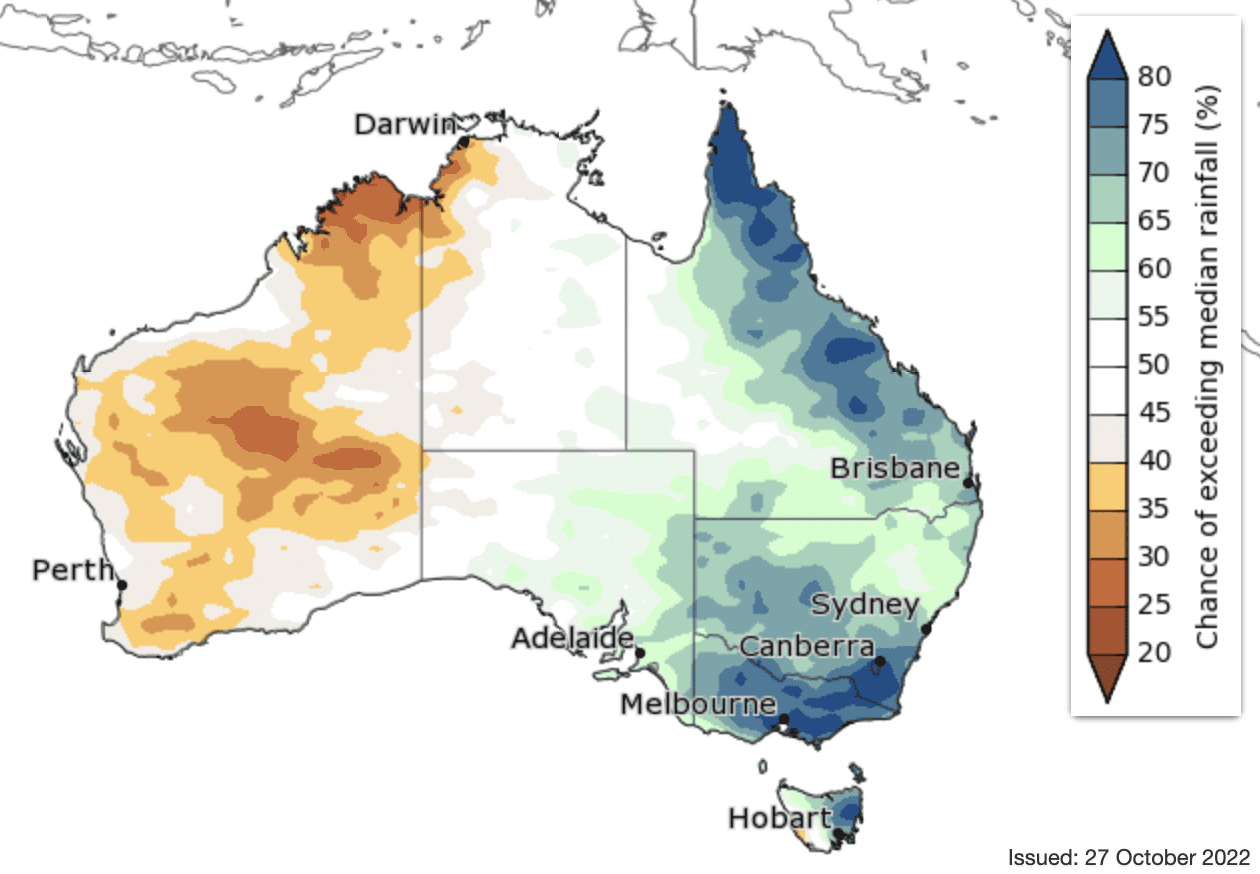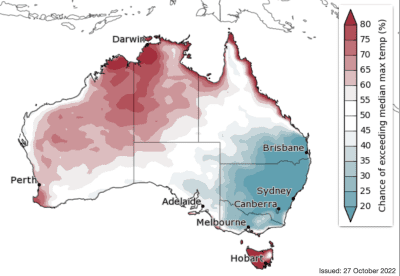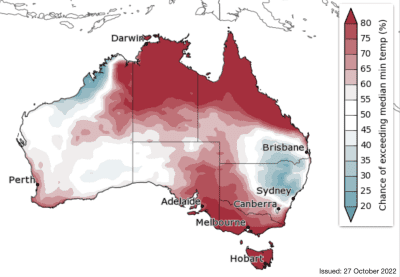
RAINFALL is likely to be above median for most of eastern Australia over the next three months, with the highest probabilities occurring in November, but below median falls are likely for large parts of Western Australia.
For the fortnight 31 October to 13 November, above median rainfall is likely for most of eastern Australia This increases to very likely for north-east and far south-east parts of the mainland. Below median rainfall is likely for large parts of Western Australia extending into the western Northern Territory. This increases to very likely around the Kimberley.
Maximum temperatures are likely to be warmer than median for much of north-west Australia and Tasmania. Below median temperatures are likely for southern Queensland, and most of New South Wales and Victoria. This increases to very likely for eastern parts of New South Wales and south-east Queensland.
Minimum temperatures are likely to be warmer than median for much of the northern halves of Queensland and the Northern Territory, and south-eastern Australia. Chances increase to very likely for the northern halves of the Northern Territory and Queensland, western and southern Victoria, far south-east South Australia, and Tasmania. Below median temperatures are moderately to highly likely along the Kimberley coast and over north-east New South Wales, extending into southern parts of Queensland.
Several climate drivers are contributing to this wet outlook, including La Niña, a negative Indian Ocean Dipole, an expected positive phase of the Southern Annular Mode for most of November and December, and warmer waters around Australia. The Madden–Julian Oscillation may also contribute to wetter conditions for eastern parts of Australia over the next fortnight.
Temperature
 Cooler days likely for most of Victoria, New South Wales, and southern Queensland during November to January; warmer for Tasmania and parts of northern and western Australia
Cooler days likely for most of Victoria, New South Wales, and southern Queensland during November to January; warmer for Tasmania and parts of northern and western Australia
For the fortnight 31 October to 13 November, maximum temperatures are very likely (greater than 80% chance) to be above median over the northern Kimberley, Maximum temperatures are very likely (greater than 80% chance) to be cooler than median for most of the rest of the mainland.
For the fortnight 31 October to 13 November, minimum temperatures are very likely (greater than 80% chance) to be above median for the Top End and far northern Queensland. Below-median temperatures are likely (greater than 60% chance) to very likely (greater than 80% chance) for northern and inland parts of Western Australia, central Australia, southern Queensland and most of New South Wales.
For the fortnight 31 October to 13 November, there is more than double the average chance of unusually cool maximum temperatures (in the coolest 20% of fortnights at this time of year during 1981 to 2018) for large parts of the mainland; chances increase to greater than four times the average for the inland south-east. There is more than double the average chance of unusually high maximum temperatures for the northern Kimberley and the Daly district of the Northern Territory.
 For the fortnight 31 October to 13 November, there is more than double the average chance of unusually high minimum temperatures for the northern halves of the Northern Territory and Queensland, and more than four times the average chance in much of this area. There is more than double the average chance of unusually cool minimum temperatures for a band across the mainland, extending from the north-west coast of Western Australia, through central Australia, across the southern half of Queensland, and northern and eastern New South Wales.
For the fortnight 31 October to 13 November, there is more than double the average chance of unusually high minimum temperatures for the northern halves of the Northern Territory and Queensland, and more than four times the average chance in much of this area. There is more than double the average chance of unusually cool minimum temperatures for a band across the mainland, extending from the north-west coast of Western Australia, through central Australia, across the southern half of Queensland, and northern and eastern New South Wales.
For November, the maximum temperature outlook is similar to the outlook for the fortnight 31 October to 13 November, though a few differences exist. For November, above median maximum temperatures are likely for most of Tasmania. The area over north-west Australia for which above-median temperatures are likely is larger for the season than for November alone, and the chance of cooler than median temperatures is somewhat lower over Western Australia.
For November, the minimum temperature outlook is also similar to the outlook for the fortnight 31 October to 13 November, with a few differences. A moderate chance of above-median minimum temperatures extends further south into the central Northern Territory. Above median minimum temperatures are very likely over Tasmania and moderately likely over Victoria and south-eastern South Australia.
November to January maximum temperatures are likely (greater than 60% chance) to very likely (greater than 80% chance) to be warmer than median for much of northern Western Australia, the Northern Territory, and Tasmania. Below median temperatures are likely (greater than 60% chance) for southern Queensland, and most of New South Wales and Victoria.
November to January minimum temperatures are likely (greater than 60% chance) to be warmer than median for much of the northern halves of Queensland and the Northern Territory, and south-eastern Australia, with chances increasing to greater than 80% for the northern halves of the Northern Territory and Queensland, western and southern Victoria, and far south-east South Australia, and Tasmania. Below median temperatures are likely (greater than 60% chance) along the Kimberley coast and over north-east New South Wales extending into southern parts of Queensland.
For November to January, there is more than triple the average chance of unusually cool maximum temperatures (in the coolest 20% of all November to January periods over 1981–2018) from the Illawarra to the Northern Rivers districts of New South Wales with the chance being more than double for most of New South Wales, parts of southern parts Queensland and parts of northern Victoria. There is more than double the average chance of unusually warm maximum temperatures for much of the Kimberley and the north-west Northern Territory, and western Tasmania.
There is at least three times the average chance of unusually high minimum temperatures (in the warmest 20% of all November to January periods over 1981–2018) for the Top End, Gulf Coast, most of far northern Queensland, and Tasmania, and twice the average chance for much of the northern half of the Northern Territory and south-east Australia.
Past accuracy of the November to January chance of above median maximum temperature long-range forecasts is high to very high across most of Australia, apart for around central parts of Northern Territory where it is moderate to high. For minimum temperatures, accuracy is moderate to high for most of Australia, with moderate to low skill around north-east Kimberley and central parts of Northern Territory.
Source: Bureau of Meteorology


HAVE YOUR SAY